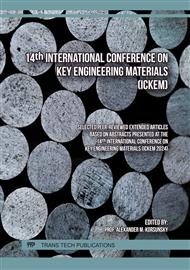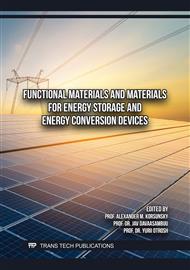[1]
V. Kumar, P. Singh, J. Sharma, S. Saini, P. Sharma, and A. Sharma, "Rice straw management through biofuel, biochar, mushroom cultivation, and paper production to overcome environmental pollution in North India," Waste Disposal and Sustainable Energy. Springer, 2023.
DOI: 10.1007/s42768-023-00152-4
Google Scholar
[2]
S. Chakroborty et al., "Sustainable synthesis of multifunctional nanomaterials from rice wastes: a comprehensive review," Environmental Science and Pollution Research, vol. 30, no. 42. Springer Science and Business Media Deutschland GmbH, p.95039–95053, Sep. 01, 2023.
DOI: 10.1007/s11356-023-29235-9
Google Scholar
[3]
S. P. Bangar, W. S. Whiteside, P. Kajla, and M. Tavassoli, "Value addition of rice straw cellulose fibers as a reinforcer in packaging applications," International Journal of Biological Macromolecules, vol. 243. Elsevier B.V., Jul. 15, 2023.
DOI: 10.1016/j.ijbiomac.2023.125320
Google Scholar
[4]
R. K. Rathour et al., "Recent Trends, Opportunities and Challenges in Sustainable Management of Rice Straw Waste Biomass for Green Biorefinery," Energies, vol. 16, no. 3. MDPI, Feb. 01, 2023.
DOI: 10.3390/en16031429
Google Scholar
[5]
S. R. E. Mohamed, M. R. R. Abdul-Aziz, S. Saber, G. Khabiri, and A. S. G. Khalil, "Precise engineering of Fe3O4/MWCNTs heterostructures for high-performance supercapacitors," J Alloys Compd, vol. 957, Sep. 2023.
DOI: 10.1016/j.jallcom.2023.170281
Google Scholar
[6]
M. A. Belal, R. Yousry, G. Taulo, A. A. AbdelHamid, A. El. Rashed, and A. Abd El-Moneim, "Layer-by-Layer Inkjet-Printed Manganese Oxide Nanosheets on Graphene for High-Performance Flexible Supercapacitors," ACS Applied Materials & Interfaces, vol. 16, no. 46, pp.53632-53643, Nov. 2023.
DOI: 10.1021/acsami.3c07339
Google Scholar
[7]
A. M. Patil et al.' "Bilateral growth of monoclinic WO3 and 2D Ti3C2Tx on 3D free-standing hollow graphene foam for all-solid-state supercapacitor," Chemical Engineering Journal, Vol. 421, Part 2, p.127883, 2021.
DOI: 10.1016/j.cej.2020.127883
Google Scholar
[8]
A. M. Patil et al., "Fabrication of a High-Energy Flexible All-Solid-State Supercapacitor Using Pseudocapacitive 2D-Ti3C2Tx-MXene and Battery-Type Reduced Graphene Oxide/Nickel- Cobalt Bimetal Oxide Electrode Materials," ACS Applied Materials & Interfaces, vol. 12, no. 47, pp.52749-52762, 2020.
DOI: 10.1021/acsami.0c16221
Google Scholar
[9]
Z. You et al., "Highly tunable three-dimensional porous carbon produced from tea seed meal crop by-products for high performance supercapacitors," Appl Surf Sci, vol. 607, Jan. 2023.
DOI: 10.1016/j.apsusc.2022.155080
Google Scholar
[10]
T. Manimekala, R. Sivasubramanian, S. Karthikeyan, and G. Dharmalingam, "Biomass derived activated carbon-based high-performance electrodes for supercapacitor applications," Journal of Porous Materials, vol. 30, no. 1, p.289–301, Feb. 2023.
DOI: 10.1007/s10934-022-01338-7
Google Scholar
[11]
H. Parsimehr, A. Ehsani, and S. A. Payam, "Electrochemical energy storage electrodes from rice biochar," Biomass Conversion and Biorefinery, vol. 13, no. 14. Springer Science and Business Media Deutschland GmbH, p.12413–12429, Sep. 01, 2023.
DOI: 10.1007/s13399-021-02089-2
Google Scholar
[12]
R. Jiang et al., "Rice straw-derived activated carbon/nickel cobalt sulfide composite for high performance asymmetric supercapacitor," Diam Relat Mater, vol. 139, Nov. 2023.
DOI: 10.1016/j.diamond.2023.110322
Google Scholar
[13]
K. Charoensook et al., "Preparation of porous nitrogen-doped activated carbon derived from rice straw for high-performance supercapacitor application," J Taiwan Inst Chem Eng, vol. 120, pp.246-256, Mar. 2021.
DOI: 10.1016/j.jtice.2021.02.021
Google Scholar
[14]
B.A. Ali, A.M.A. Omar, A.S.G. Khalil, N.K. Allam, "Untapped potential of polymorph MoS2: tuned cataionic intercalation for high-performance symmetric supercapacitors," ACS Appl. Mater. Interfaces, vol. 11, pp.33955-33965, 2019.
DOI: 10.1021/acsami.9b11444
Google Scholar
[15]
Y. Gao, R. Sun, A. Li, and G. Ji, "In-situ self-activation strategy toward highly porous biochar for supercapacitors: Direct carbonization of marine algae," Journal of Electroanalytical Chemistry, vol. 882, Feb. 2021.
DOI: 10.1016/j.jelechem.2021.114986
Google Scholar



